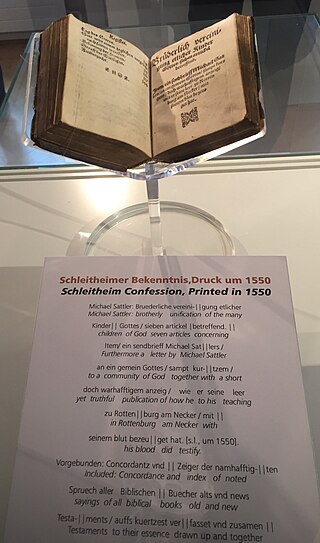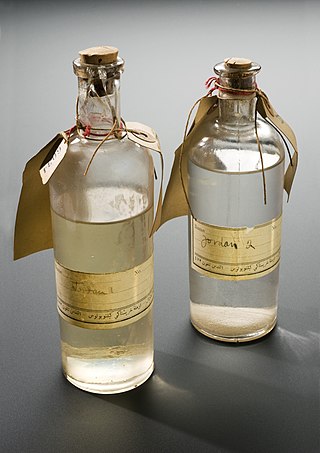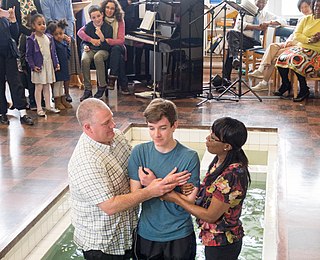
Baptism is a Christian sacrament of initiation and adoption, almost invariably with the use of water. It may be performed by sprinkling or pouring water on the head, or by immersing in water either partially or completely, traditionally three times, once for each person of the Trinity. The synoptic gospels recount that John the Baptist baptised Jesus. Baptism is considered a sacrament in most churches, and as an ordinance in others. Baptism according to the Trinitarian formula, which is done in most mainstream Christian denominations, is seen as being a basis for Christian ecumenism, the concept of unity amongst Christians. Baptism is also called christening, although some reserve the word "christening" for the baptism of infants. In certain Christian denominations, such as the Catholic Churches, Eastern Orthodox Churches, Oriental Orthodox Churches, Assyrian Church of the East, and Lutheran Churches, baptism is the door to church membership, with candidates taking baptismal vows. It has also given its name to the Baptist churches and denominations.

Infant baptism is the practice of baptizing infants or young children. Infant baptism is also called christening by some faith traditions.

Anointing is the ritual act of pouring aromatic oil over a person's head or entire body.

In Christian denominations that practice infant baptism, confirmation is seen as the sealing of the covenant created in baptism. Those being confirmed are known as confirmands. For adults, it is an affirmation of belief. It involves laying on of hands.

A baptismal font is an ecclesiastical architectural element, which serves as a receptacle for baptismal water used for baptism, as a part of Christian initiation for both rites of infant and adult baptism.

The Didache, also known as The Lord's Teaching Through the Twelve Apostles to the Nations, is a brief anonymous early Christian treatise written in Koine Greek, dated by modern scholars to the first or second century AD.

Anabaptist theology, also known as Anabaptist doctrine, is a theological tradition reflecting the doctrine of the Anabaptist Churches. The major branches of Anabaptist Christianity agree on core doctrines but have nuances in practice. While the adherence to doctrine is important in Anabaptist Christianity, living righteously is stressed to a greater degree.
In Christian theology, baptism with the Holy Spirit, also called baptism in the Holy Spirit or baptism in the Holy Ghost, has been interpreted by different Christian denominations and traditions in a variety of ways due to differences in the doctrines of salvation and ecclesiology. It is frequently associated with incorporation into the Christian Church, the bestowal of spiritual gifts, and empowerment for Christian ministry. Spirit baptism has been variously defined as part of the sacraments of initiation into the church, as being synonymous with regeneration, as being synonymous with Christian perfection that empowers a person for Christian life and service. The term baptism with the Holy Spirit originates in the New Testament, and all Christian traditions accept it as a theological concept.

Holy water is water that has been blessed by a member of the clergy or a religious figure, or derived from a well or spring considered holy. The use for cleansing prior to a baptism and spiritual cleansing is common in several religions, from Christianity to Sikhism. The use of holy water as a sacramental for protection against evil is common among Lutherans, Anglicans, Roman Catholics, and Eastern Christians.
Aspersion, in a religious context, is the act of sprinkling with water, especially holy water. Aspersion is a method used in baptism as an alternative to immersion or affusion. The word is formed of the Latin aspergere, 'to sprinkle', of ad, 'to', and spargo, 'I scatter'.

Catechesis is basic Christian religious education of children and adults, often from a catechism book. It started as education of converts to Christianity, but as the religion became institutionalized, catechesis was used for education of members who had been baptized as infants. As defined in the Catechism of the Catholic Church, paragraph 5 :
Catechesis is an education in the faith of children, young people and adults which includes especially the teaching of Christian doctrine imparted, generally speaking, in an organic and systematic way, with a view to initiating the hearers into the fullness of Christian life.

Conversion to Christianity is the religious conversion of a previously non-Christian person that brings about changes in what sociologists refer to as the convert's "root reality" including their social behaviors, thinking and ethics. The sociology of religion indicates religious conversion was an important factor in the emergence of civilization and the making of the modern world. Conversion is the most studied aspect of religion by psychologists of religion, but there is still very little actual data available. Neurological studies have determined that conversion is not the result of pathology.
Baptism is a rite of admission into the Christian church.
The Evangelical Protestant Church (GCEPC) or The Lutheran Evangelical Protestant Church (LEPC) is a mainline Protestant denomination under the General Conference of Evangelical Protestant Churches headquartered in Cayce-West Columbia, South Carolina, United States.

Believer's baptism or adult baptism is the practice of baptizing those who are able to make a conscious profession of faith, as contrasted to the practice of baptizing infants. Credobaptists believe that infants incapable of consciously believing should not be baptized.

Immersion baptism is a method of baptism that is distinguished from baptism by affusion (pouring) and by aspersion (sprinkling), sometimes without specifying whether the immersion is total or partial, but very commonly with the indication that the person baptized is immersed in water completely. The term is also, though less commonly, applied exclusively to modes of baptism that involve only partial immersion.
Baptism has been part of Christianity from the start, as shown by the many mentions in the Acts of the Apostles and the Pauline epistles.

John the Baptist, who is considered a forerunner to Christianity, used baptism as the central sacrament of his messianic movement. Christians consider Jesus to have instituted the sacrament of baptism. The earliest Christian baptisms were by immersion. By the third and fourth centuries, baptism involved catechetical instruction as well as chrismation, exorcisms, laying on of hands, and recitation of a creed. In the West, affusion became the normal mode of baptism between the twelfth and fourteenth centuries, though immersion was still practiced into the sixteenth. In the sixteenth century, Martin Luther retained baptism as a sacrament, but Swiss reformer Huldrych Zwingli considered baptism and the Lord's supper to be symbolic. Anabaptists denied the validity of infant baptism, which was the normal practice when their movement started and practiced believer's baptism instead. Several groups related to Anabaptism, notably the Baptists and Dunkards, soon practiced baptism by immersion as following the Biblical example.
The Jesus' name doctrine or the Oneness doctrine upholds that baptism is to be performed "in the name of Jesus Christ," rather than using the Trinitarian formula "in the name of the Father, and of the Son, and of the Holy Spirit." It is most commonly associated with Oneness Christology and the movement of Oneness Pentecostalism; however, some Trinitarians also baptise in Jesus' name and interpret it as on the authority of Jesus' name which most of mainstream Christendom justifies as referencing the existence of a Trinitarian Christian deity through the Great Commission among other precepts such as instances in the Old Testament.

In Reformed theology, baptism is a sacrament signifying the baptized person's union with Christ, or becoming part of Christ and being treated as if they had done everything Christ had. Sacraments, along with preaching of God's word, are means of grace through which God offers Christ to his elect. Sacraments are believed to have their effect through the Holy Spirit, but these effects are only believed to accrue to those who have been predestined to have faith in Christ.














